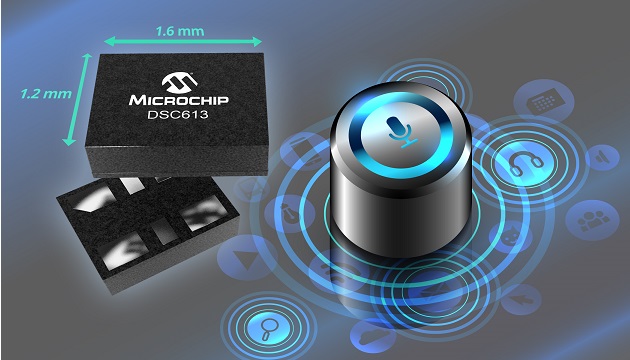As consumer demand for compact Internet of Things (IoT) and portable electronics devices accelerates, product designers need to find solutions that reduce application size while extending battery life. Timing devices are central to the operation of these products, but clock sources traditionally require multiple components to meet the frequency requirements of consumer devices, thus consuming board space and power.
To resolve these design challenges, Microchip Technology has announced the industry’s smallest MEMS clock generator. This new device can replace up to three crystals and oscillators on a board, reducing timing component board space by up to 80 percent. The DSC613 clock family eliminates the need for an external crystal by integrating a low-power and high-stability Micro-Electro-Mechanical Systems (MEMS) resonator.
To support the range of frequencies required in today’s smart devices, system designers need to either place multiple crystals/oscillators next to the controllers on a board or use a clock generator with an external crystal for the reference input. The DSC613 family is a true single-chip solution that integrates a MEMS resonator and two low-power Phase-Locked Loops (PLLs) into a 6-pin DFN package as small as 1.6 mm x 1.2 mm.
The compact package size and extensive frequency flexibility makes the DSC613 family well suited for compact devices that require low-power operation, such as digital cameras, smart speakers, Virtual Reality (VR) headsets, streaming sticks and set-top boxes.
The DSC613 family supports up to three clock outputs from 2 kilohertz (kHz) to 100 megahertz (MHz), making it ideal for microcontroller-based embedded systems. In an IoT application, for example, the clock generator can be used to provide a MHz main reference clock and 32.768 kHz Real-Time Clock (RTC) for the microcontroller (MCU), as well as another MHz clock for functions such as connectivity and sensors.
The DSC613 family includes two low-power fractional PLLs with AnyRate clock synthesisers, which enable the device to generate any frequency between 2 kHz and 100 MHz. At approximately five milliamps (mA) power consumption with three outputs running, the family provides up to 45 percent power savings when compared to a solution that uses three low-power quartz oscillators. For additional power savings, the clock output can be turned off through the output enable pin.
“Microchip is the only one-stop-shop timing supplier that offers network synchronisation, clock generation and buffer, as well as MEMS, crystal and SAW-based oscillators ranging in frequencies from kHz up to GHz,” said Rami Kanama, vice president of Microchip’s timing and communications business unit. “As the latest addition to an already-extensive MEMS timing offering, the DSC613 clock generation family provides a true single-chip timing solution to MCU-based systems, making it a great clock companion to Microchip’s MCU and MPU devices.”
MEMS products are built entirely with standard semiconductor processes, providing the same reliability and stability as integrated circuits, and the devices support up to -40 to +125 degrees Celsius temperature range with a stability of ± 20ppm. All products are backed by Microchip’s customer-driven obsolescence practice that ensures that devices will be available for as long as customers need them.
Development Tools
The DSC613 family is supported by Microchip’s ClockWorks online configurator tool. Customers can enter a clock configuration and receive a customised part number and datasheet, as well as order free samples all in one place at microchip.com.
Clock configuration includes output frequency, control pin function, package size, PPM accuracy and temperature range. Up to three output drive strengths are available based on the custom board loading condition. Spread-spectrum clocks are also available for EMI reduction. Application support, including board layout guidelines and schematics review, is also available.
Availability
The DSC613 family is available now for sampling and in volume production. For pricing and additional information, contact a Microchip sales representative, authorised worldwide distributor or visit Microchip’s website.









